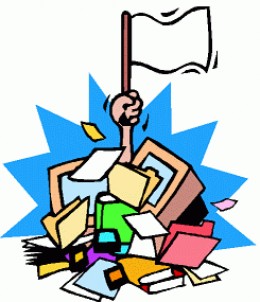Do you dread entering your laundry area because it’s filled with piles of dirty clothes and who knows what else? Now is a good time to make a clean, fresh start!
1. Visualize your ideal space.
· Picture how you would like the room to look and consider how it should better function.
2. Reduce the excess.
· Remove items that don’t belong in the laundry room and put them where they really should live.
· Eliminate items you don’t want (use up, share with others, donate, or toss).
3. Maximize the space.
· Install shelves or cabinets above and/or next to washer and dryer.
· If space allows, place a narrow rolling cart between your washer and dryer to store small items.
· Install a wall-hanging ironing board, hanging rack and/or folding table to save space.
4. Organize what you keep.
· Assign a home for each item, keeping similar items together.
· Keep frequently-used items close at hand and less-frequently used items higher or lower.
· Dedicate space for sorting dirty clothes; use bins or rolling carts to separate and contain whites, colors, delicates, and heavily soiled items.
6. Decorate the room.
· Hang artwork, put down a throw rug, purchase attractive hampers, etc. so you feel happy and peaceful in the room.
7. Develop a laundry schedule.
· Make doing laundry a ROUTINE – daily, every other day, weekly, etc.
· Make it as enjoyable as possible – fold laundry while watching TV, talking on phone, etc.
8. Get help from family members.
· Have family members empty pockets, pre-spot and put their dirty clothes in the hamper.
· Delegate the folding of clean laundry and putting clothes away.
9. Follow through!
· Complete the laundry cycle and put clothes away and have family members do the same.
· Reward yourselves with a treat when you’ve completed the process.
BONUS TIP #1: To have a truly clean start, take your accumulated laundry to your local laundromat and have them do the wash for you. Approximate cost = $1.00/lb.
BONUS TIP #2: Use Color Catchers (by Shout) or Color Grabber (by Carbona) when washing lights and darks together. They really do catch the color!
 Believe it or not, it only takes a few steps to get your online files organized. Below are seven steps to help you save countless hours and avoid those embarrassing situations that come from searching for lost files. Let’s get started!
Believe it or not, it only takes a few steps to get your online files organized. Below are seven steps to help you save countless hours and avoid those embarrassing situations that come from searching for lost files. Let’s get started!
1. Start at the Root
Determine where you want your file system to live on your computer. Having all your files and documents under one ‘root’ folder on your computer will make it easy to locate your files. Many single Windows users have all their folders, files, and documents stored haphazardly in the ‘Documents’ or ‘My Documents’ folder on their PC. If this sounds like your system, then you might want to consider starting from scratch. The easiest way to do this is to save all your current folders, files, and documents to a new folder and name it something like Archive_2015 or any appropriate name that’s easy to remember. Now you can start to create a new file structure with broad categories without losing any of your current information. After your new filing system is created, you can move previously created files and documents to the newly created system on an as needed basis.
2. Create a File Structure
File structure is the backbone of your filing system and it begins with using folders for general categories. Think big when creating filing categories and limit the number of folders to a critical few. Describe the contents of the folders with short commonly used, meaningful terms. Start broad and get more specific as you add files and documents to those broad category folders.
Examples for business folder names:
Administration
Clients
Financial
Insurance
Legal
Marketing
Organizations
Sales
Vendors
Projects
Examples for personal folder names:
Financial
Medical
Health & Wellness
Housing
Insurance
Taxes
3. Use Sub-Categories
After you have created your folders using broad categories, you will want to create files with sub-categories. Sub-categories are used to organized those files and documents within your folders. You may have a folder called ‘Projects’ and within that folder are several files or sub-categories called Project-A, Project-B and Project–C.
4. Determine a Naming Convention
It’s important to name your folders and files consistently and logically. Storing multiple drafts of the same document can get confusing, and a naming convention is one way to avoid that confusion. Also, adding a date at the end of the file name is a great way to keep track of multiple documents, and the addition of initials at the end of the file name will add clarity if more than one person is working on the same document.
Naming convention examples:
Jane_Doe
Jane_Doe_1/1/15
Jane_Doe_1/1/15_JD
5. ‘Save As’ You Go
File your documents in the proper location by using the ‘Save As’ feature. ‘Save As’ allows you to save and file your documents as you go, so they will be placed in the correct file or folder from the start.
6. Clean Up Your Desk Top
Evaluate what you really use and delete those icons or shortcuts that are outdated or infrequently used. Note: deleting a shortcut is not the same as deleting a file, folder or program from your computer. Deleting the shortcut will simply remove it from your desktop. A program like Fences is a great way to automatically sort out all those remaining icons into organized, easy to see boxes and categories. The program can sort the categories for you or you can create your own categories.
7. Backup Your Files
Have a regiment in place to regularly back up your files. If your hard drive fails or is damaged and your only source of backup is your computer, then you risk losing all of your business transactions and correspondence. The rule of thumb for data protection is “if you need it to run your business, then back it up.” Having all your files saved to a ‘root’ will make that process easy.
Everyone has a different threshold for what it takes to go from manageable to maniacally crazed. In honor of National Clean Out Your Computer Day, celebrated the second Monday in February, I offer advice on four hot spots for digital clutter:
My advice: focus your efforts on one of the four electronic clutter hot spots OR do a little purging in each category to get yourself calm and collected — literally.
When you approach winnowing your documents, photos, desktop or email, get ready for a trip down memory lane. You will be reminded of things you’ve completely forgotten — and some should remain forever forgotten, but some should be resurrected…or completed. It’s helpful to have a notepad next to you to jot down the name of a particular file that you want to compare to others and select the best version. You may want to start a to-do list for future decluttering projects. Clearing out your computer can get addictive…
EMAIL: Without getting into specifics about which apps work best on which platforms, the principles of email management are consistent:
YOUR DESKTOP: Go for Zen on your desktop and completely clear it! Apart from straining your computer to refresh icons continually, desktops are there to provide the calm visual space your brain craves while processing data. While your desktop may seem like an infinite holding basket for what’s important at the moment, or a safe place to store what might get lost, left unchecked it will become a graveyard of expired photos, files, and reminders. A final caution: desktop items are typically not included in routine back-ups.
PHOTO MANAGEMENT: When there is no monetary cost involved in taking photos there is little motivation to weed out bad shots and duplicates: except photos take up a LOT of memory. So rather than pay for upgrades, take a look at your stockpile of digital pics and decide on your keepers. Trash the rest. Do not attempt to manage your photos in a day; a few hours a week is a good goal until you have controlled your collection to date, and then a half-hour a week to maintain going forward. If that seems too daunting…just deal with the photos from January 1, 2015 and tackle your larger collection with a pro.
DOCUMENTS: The two biggest categories to tackle are:
YOU have to decide what maintenance schedule will work for your lifestyle…but National Clean Out Your Computer Day aside, once a year is not enough.
I look at the last week of the year as a super productive week since I am not scheduled to work, and I can spend time getting myself ready for the new year. I want to be as organized as possible before January 5, 2015, which is my first day back to work! Below is a list of suggestions that may help you start your new year off a bit more organized.
Donations 
-If you want to maximize your donations for the 2014 tax year, take one more look through your closets, bookshelves, cabinets, attics, basements and garages to pull anything out that needs to be donated. Children’s toys and books are usually a gold mine for most donation establishments.
-After the holidays, as you integrate your new gifts, take stock of your duplicates, triplicates or otherwise unwanted things that can be better utilized by others.
-Keep in mind that you shouldn’t wait until December 31 to drop off your donations, because if the center hits their capacity level, they may stop accepting donations.
-Some donation centers will pick up your unwanted goods as long as you are on their schedule. Some donation center choices are GreenDrop, Vietnam Veterans of America, The Salvation Army, and Impact Thrift Stores.
-Make your final online cash donations as soon as possible since you don’t want to get stuck with slow or crashing websites at the last minute.
Files 
-Assuming that you have them, the end of the year is a great time to purge your old files and create new ones. If you need help creating a filing system, a professional organizer can help. You can go to the ‘Find an Organizer’ tab at the top of this page.
-Go through your 2014 bills, pull them out of their files, and clip or band them together if you are going to need them for your taxes. If you don’t need them for your taxes, I would suggest shredding anything that has personal information or account numbers. Most of my clients shred their department store bills and hold onto some of their utility bills for another year (I think they just want the security of having them…just in case).
– A filing cabinet or file box are both great choices to keep your files organized and accessible.
-If you scan your bills and receipts, remember to create new files on your computer.
Hopefully, there is something here that will help you start 2015 off with a little more organization in your world.
 Although we tend to hear a lot about the importance of time and task management, more often than not, there is a more effective approach, and that is in the way we manage our CHOICES. Choices are made daily and affect every aspect of our day. Some examples are:
Although we tend to hear a lot about the importance of time and task management, more often than not, there is a more effective approach, and that is in the way we manage our CHOICES. Choices are made daily and affect every aspect of our day. Some examples are:
-What to do next
-What to say
-What to eat
Many things dictate and influence our decisions such as our intuition, our subconscious, outside deadlines, ease of choice, and pain vs. pleasure just to name a few. How many decisions are made by default, rather than by design? Also, what criteria is best to use when making choices?
The easiest way to make healthy, wise choices is to have clear-set goals. Knowing what you want to accomplish or achieve, setting a time-frame to achieve said goals, and asking yourself if your choices are taking you closer to your goals or moving you farther away from them is a step in the right direction.
Although it is not ideal, letting external deadlines dictate our actions is certainly one way to manage time and tasks. We are forced to focus on that ONE task in order to meet the deadline, but when this happens, we are reactive and not proactive. While it helps to eliminate making choices, it adds unnecessary stress.
Instead, I have found that what works for me is if I ‘check in’ with myself throughout the day and ask if what I am doing is the most effective behavior to meet my goals. The goals might be to maintain good health, grow my business, be in touch with friends and family, give back to the community or create life balance. Sometimes, I catch myself making decisions that may not be the best choice, such as a glass of wine instead of a workout on the treadmill. I check in with myself and confirm that I do want to make good choices and make a mental note be more mindful. For instance, I can work out and then have a glass of wine!
I invite you to think about the choices you make and to compare them to your goals. Are they in alignment? If not, what choices can you make to make a change? Remember, all it takes is ‘baby steps’ to come closer to achieving your goals?
There is a weird magnetic field between my garage door and the stoplight half a mile down the road. So often I get pulled back to my garage five minutes after leaving to gather some forgotten item. Sometimes it happens more than once on the same trip!
Do you often leave the house more than once?
Yes, I’m organized, but it still happens. Hey, no one is perfect.
I recently started investigating why this happens and whether it can be fixed.
Harold Taylor, a noted time management expert, told about how he takes a daily walk, after which he sits down to write an article or two. One year his kids got him a portable music device for his walks. He enjoyed the music, but he found that when he reached his destination, the articles wouldn’t come. What changed? His brain needed the quiet time during his walk for him to consistently write articles.
Many people today just don’t have any quiet time in their day. Certainly, those five minutes between the back door and the garage are hectic, and hectic is where chaos happens.
Hectic is where things get forgotten, accidents happen, and commitments are missed.
Unfortunately, my brain thinks the five minutes after I get in the car are my quiet time. After I’ve cleared the kitchen counter, grabbed my bags, and made it out of the clutches of little hands who want just one more hug — sitting in the car IS quiet time. With all of the household and family duties behind, my mind is captive in the car and starts planning the details of events I’m heading to and the commitments in the rest of my day.
That is when forgotten details pop into my head, usually right around the time I reach that first stoplight.
If this happens to you more often than you’d like, there is an easy fix. Actually, two fixes:
1. Checklists — Similar to notepads that some people hang on the doorknob to remind them of things to take out of the house, I have one inside my car that I check before leaving for an appointment. Going through the checklist forces me to switch gears before I leave the driveway, and at least I don’t forget the obvious items. For a client who often has a dead battery because she leaves her car lights on, I created a checklist of what to do before she exits her car with 3 things on it:
• Turn off headlights (her car doesn’t have automatic shut off)
• Check teeth and lipstick
• Grab purse and lunch bag
Could you make a checklist like this?
2. Breathe — Give it a moment, maybe in the front seat while you are still parked in the driveway. It’s easy to stay on the go, not miss a step in your day, but 60 seconds with your eyes closed, mentally running through the task coming up next might be all you need. Picture what you’ll be carrying, where you’re going, who you’ll see, and your essential items will pop into your head more times than not.
So simple, right? Simple, but not easy. If you do one of these fixes, you’ll be more less frantic and more organized. If you do both, you’ll be an organizing rock star. I think I hear your band warming up now!